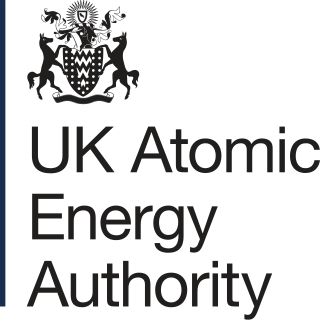
The Atomic Energy Research Establishment (AERE) was the main centre for atomic energy research and development in the United Kingdom from 1946 to the 1990s. It was created, owned and funded by the British Government.

The Atomic Weapons Establishment (AWE) is a United Kingdom Ministry of Defence research facility responsible for the design, manufacture and support of warheads for the UK's nuclear weapons. It is the successor to the Atomic Weapons Research Establishment (AWRE) with its main site on the former RAF Aldermaston and has major facilities at Burghfield, Blacknest and RNAD Coulport.

The United Kingdom Atomic Energy Authority is a UK government research organisation responsible for the development of fusion energy. It is an executive non-departmental public body of the Department for Energy Security and Net Zero (DESNZ).

Dounreay is a small settlement and the site of two large nuclear establishments on the north coast of Caithness in the Highland area of Scotland. It is on the A836 road nine miles west of Thurso.
Atomic Energy Act is a stock short title used for legislation in the United Kingdom and the United States relating to nuclear power and, or alternatively, nuclear weapons production.

Amersham plc was a manufacturer of radiopharmaceutical products, to be used in diagnostic and therapeutic nuclear medicine procedures. The company became GE Healthcare following a takeover in 2003, which was based at the original site in Amersham, Buckinghamshire until 2016, when the headquarters moved to Chicago.

The United Kingdom Atomic Energy Authority Constabulary was the armed security police force of the United Kingdom Atomic Energy Authority. The force existed for 50 years, operating from 1955, until 1 April 2005.

The Environmental Protection Act 1990 is an Act of the Parliament of the United Kingdom that as of 2008 defines, within England and Wales and Scotland, the fundamental structure and authority for waste management and control of emissions into the environment.

Margaret Mary Gowing (née Elliott), was an English historian. She was involved with the production of several volumes of the officially sponsored History of the Second World War, but was better known for her books, commissioned by the United Kingdom Atomic Energy Authority, covering the early history of Britain's nuclear weapons programmes: Britain and Atomic Energy 1939–1945, published in 1964, and the two-volume Independence and Deterrence: Britain and Atomic Energy 1945–52, published in 1974.

The Coal Industry Nationalisation Act 1946 was an Act of the Parliament of the United Kingdom which nationalised, or brought into state control, the coal industry in the United Kingdom. It established the National Coal Board as the managing authority for coal mining and coal processing activities. It also initially provided for the establishment of consumers' councils. The Coal Industry Nationalisation Act 1946 was the first of a number of Acts promulgated by the post-war Labour government to nationalise elements of the UK's industrial infrastructure; other Acts include the Electricity Act 1947; the Transport Act 1947 ; the Gas Act 1948; and the Iron and Steel Act 1949.

The Electricity Act 1989 provided for the privatisation of the electricity supply industry in Great Britain, by replacing the Central Electricity Generating Board in England and Wales and by restructuring the South of Scotland Electricity Board and the North of Scotland Hydro-Electric Board. The Act also established a licensing regime and a regulator for the industry called the Office of Electricity Regulation (OFFER), which has since become the Office of Gas and Electricity Markets (OFGEM).

The Atomic Energy Authority Act 1954 is an act of the Parliament of the United Kingdom which established the United Kingdom Atomic Energy Authority with powers to produce, use and dispose of atomic energy and to carry out research into this and related matters.

The Atomic Energy Authority Act 1959 is an Act of the Parliament of the United Kingdom which amended and extended the constitution and powers of the United Kingdom Atomic Energy Authority.
The National Institute for Research in Nuclear Science was a UK Government establishment that provided equipment and facilities for nuclear research that would otherwise be beyond the financial capability of individual universities and other nuclear research establishments. It operated from 1957 to 1965.

Calder Hall Nuclear Power Station is a former Magnox nuclear power station at Sellafield in Cumbria in North West England. Calder Hall was the world's first full-scale commercial nuclear power station to enter operation, and was the sister plant to the Chapelcross plant in Scotland. Both were commissioned and originally operated by the United Kingdom Atomic Energy Authority. The primary purpose of both plants was to produce weapons-grade plutonium for the UK's nuclear weapons programme, but they also generated electrical power for the National Grid.

The Atomic Energy Authority Act 1971 is an Act of Parliament of the United Kingdom. The principal effect of the Act was to transfer certain functions, property and responsibilities of the United Kingdom Atomic Energy Authority to two newly established organisations, namely the British Nuclear Fuels Limited and The Radiochemical Centre Limited.

The Atomic Energy Authority Act 1973 is an Act of Parliament of the United Kingdom. The effect of the Act was to transfer the functions, property, liabilities and responsibilities related to atomic weapons from the Weapons Group of the United Kingdom Atomic Energy Authority to Ministry of Defence.

The Atomic Energy Authority Act 1986 is an act of Parliament of the United Kingdom. The effect of the Act was to put the finances of the United Kingdom Atomic Energy Authority (UKAEA) on a trading fund basis, such that what the Authority charged its customers included an element of profit.

The Nuclear Safeguards Act 2000 is an Act of Parliament of the United Kingdom. Its effect was to enact in the UK the provisions of the 1998 Treaty on the Non-Proliferation of Nuclear Weapons.

The Atomic Energy Act 1946 is an Act of Parliament of the United Kingdom which vested in the Minister of Supply the power to control and promote the development of Atomic Energy in the UK.









